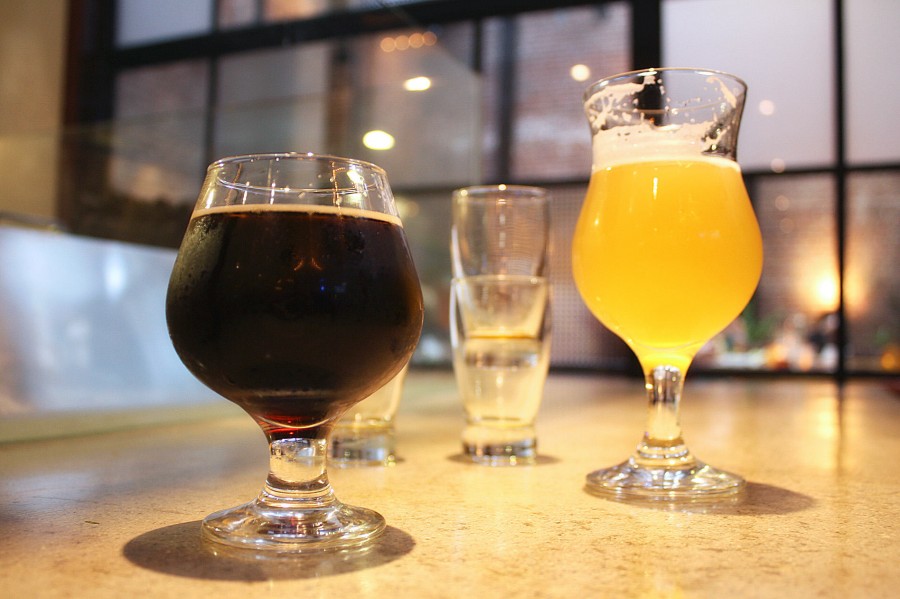
Is Draft Beer Really Better?
As Americans become more interested in good beer, more and more people are venturing out to bars to try different delicious brews. More breweries are popping up all over the country, LA being one of the budding cities.
So, you want to get into beer right? I’ll bet that if you go to a bar, you usually get
what’s on tap without thinking about it. It makes sense…so you think. Does it really though?
It’s a complicated topic. Sure, tap beer may seem fresher, tastier and just plain better. However, that’s not always the case. Ever had a flat, watery, or just plain nasty beer on tap? Yeah, many of us have been there. Although it’s a hard subject to master, here you’ll get the rundown on what beers you should order on draft vs. bottled.
Ask any beer connoisseur and she’ll tell you, there are so, so many variables to consider when deciding on the vessel. I won’t get too deep into the technical details or rare instances, but there are a few tricks you can easily remember.
One, oxygen is the enemy. When oxygen gets in contact with beer, a chemical reaction occurs called oxidation. This can happen in many instances when handling and bottling beer. Oxidation occurs faster due to high temperature, motion, and loose caps. To minimize oxidation, it’s best to keep beer refrigerated and stable.
Two, make sure you’re drinking at a good, well-maintained bar. Going out for a beer with friends is one of the best parts of drinking. Sadly, so many beer bars do not keep clean tap lines. This means that a dirty tap line will be susceptible to bacteria, yeast, mold, and all the bad stuff that make a beer’s quality go down. Another thing to look out for at bars is carbonation. Brewers recommend a certain level of carbonation for their beer, but again, many bars don’t follow this.
Three, light is bad. Keep your beer away from light, unless you want a skunky or spoiled beer. The hops present in beer are extremely sensitive to light. It doesn’t matter whether it’s sunlight or your fridge’s light, all light is bad. This is why clear bottles should never be used for bottling beers. Green bottles are okay, but brown bottles are best at keeping the pesky UV lights away.
IPA’s
One of the most noticeable beer styles coming out of the thriving craft beer scene, IPA’s are best on tap. IPA’s are some of the hoppiest beers out there, and their characteristic strong and bitter hop flavor diminishes the longer you let it sit in your fridge. Remember skunk? Yeah, the longer your IPA is exposed to light in your fridge, the faster it’ll start to go bad. Oxidation is also bad. The hops found in IPAs are extremely sensitive. The delicious, hoppy aroma and clean bitter taste are attributed to the freshest of IPAs.
Belgians
Belgians are celebrated as being some of the best beers produced in the world. The care and dedication that goes into brewing them is unique. Many of the best Belgians are brewed by monks. That tidbit alone should tell you that these beers were made by good, caring hands. With Belgians, bottled is the way to go. Most Belgians are bottle conditioned (meaning they’re meant to be aged), and it doesn’t make much sense to serve them on tap. Carbonation is the other reason why Belgians taste better bottled. They require a specific amount of carbonation, which is best controlled by the brewery during the bottling process and varies widely in bars.
Saisons
You may think that Saisons are very similar to Belgian ales, but they’re not. “Saison” translates to “in season.” So, it makes sense that you have to drink this type of beer right away, right? Well..this is a tricky one. Traditionally, Saisons were brewed for farm workers in Belgium as a refreshing beverage for the hot summer months. Later, when Americans started brewing Saisons, they changed the whole game. Bigger ABVs, funkier and stronger, instead of a mild summer brew. If you’re going the traditional route, go for the tap, preferably in the summer season. With a stronger, American Saison, you may want to opt for the bottle. Know your brewer!
Lagers
For better or worse, lagers are America’s favorite beers. They’re light, refreshing, smooth. This is an easy one. Lagers are better on draft. The delicate essence of lagers fully shine when freshest. Low carbonated levels at a bar? It doesn’t matter because lagers don’t need much of it anyway. Also, the great thing about lagers on tap is the thick head of foam. The texture and aromas added by the beer head are part of the reason why lager’s a big favorite (It also makes the beer look delicious, doesn’t it?).
Stouts
Stouts are best served on tap. Even better if they’re served on a nitro tap: meaning they contain more nitrogen than carbon dioxide. The nitrogen results in the creamy, velvety fullness you get when sipping on that Old Rasputin nitro beer, for example. Like lagers, Stouts are usually less carbonated and are also improved by the foam, courtesy of the tap. Some Stouts also have additions, like coffee, that fade with time. Not good for aging. Go for the tap when you’re craving a Stout.
Ciders
Ciders are becoming more popular than ever before. Once thought of as a “girly” drink, Ciders are finally being recognized for their great qualities. Want to know what else makes them great? They’re gluten-free. There you go, celiacs. Drink up!
Ciders are like apple wine, and you (almost) never drink fresh wine on tap. Crisp and tart, these qualities are kept better when bottled. As Ciders gain popularity in the craft beer world, we’ll see if draft can compete with the bottles.
Do you go for the bottle or draft? Let us know your picks.


